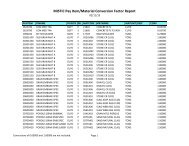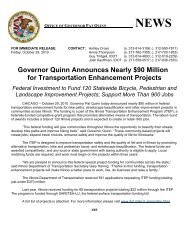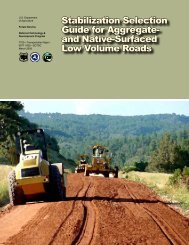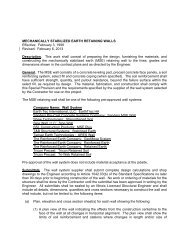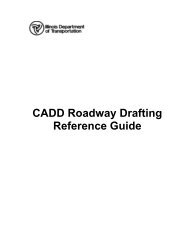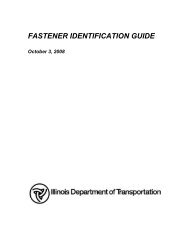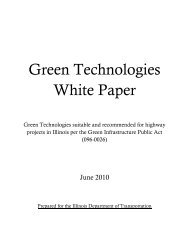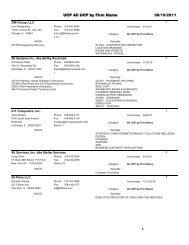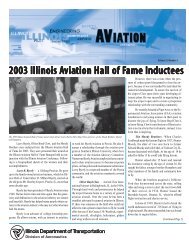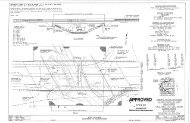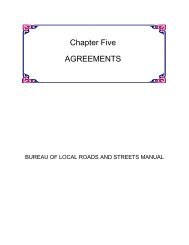All Regional Engineers John D. Baranzelli Special Provision for ...
All Regional Engineers John D. Baranzelli Special Provision for ...
All Regional Engineers John D. Baranzelli Special Provision for ...
You also want an ePaper? Increase the reach of your titles
YUMPU automatically turns print PDFs into web optimized ePapers that Google loves.
<strong>All</strong> <strong>Regional</strong> <strong>Engineers</strong><br />
<strong>John</strong> D. <strong>Baranzelli</strong><br />
<strong>Special</strong> <strong>Provision</strong> <strong>for</strong> Temporary Water Filled Barrier<br />
September 28, 2012<br />
This special provision was developed by the Bureau of Safety Engineering to<br />
provide a means of positive protection which increases worker safety by<br />
separating workers from motorized traffic in work zones that offer no means of<br />
escape.<br />
It has been revised to fit with the inclusion of the BDE special provision,<br />
“Impact Attenuators, Temporary” into the 2013 Supplemental Specifications.<br />
When this special provision is used, Recurring <strong>Special</strong> <strong>Provision</strong> Check<br />
Sheet #20, “Guardrail and Barrier Wall Delineation” should also be included in<br />
the contract.<br />
It should be inserted at the district’s discretion. Use of this special provision<br />
should be limited to cases where temporary concrete barrier is not feasible due<br />
to lane closure time restrictions that require the barrier to be deployed or<br />
removed within four hours. Use of this barrier system should also be limited to<br />
work areas where larger barrier deflection from an impact event is acceptable.<br />
The districts should include the BDE Check Sheet marked with the applicable<br />
special provisions <strong>for</strong> the January 18, 2013 letting and subsequent lettings.<br />
The Project Development and Implementation Section will include a copy in<br />
the contract.<br />
This special provision will be available on the transfer directory<br />
September 28, 2012.<br />
80256m
TEMPORARY WATER FILLED BARRIER (BDE)<br />
Effective: January 1, 2010<br />
Revised: January 1, 2013<br />
Description. This work shall consist of furnishing, installing, maintaining, relocating, and<br />
removing a temporary water filled barrier at locations shown on the plans.<br />
Materials.<br />
Add the following to Article 1106.02 of the Standard Specifications:<br />
“ (k) Temporary Water Filled Barrier. The water filled barrier shall be a lightweight plastic<br />
shell designed to accept water ballast. The barrier shall meet the requirements of<br />
NCHRP Test Level 3 or AASHTO Manual <strong>for</strong> Assessing Safety Hardware (MASH) and<br />
be on the Department’s approved list.<br />
Shop drawings shall be furnished by the manufacturer and shall indicate the deflection of<br />
the barrier as determined acceptance testing, the configuration of the barrier in that test,<br />
and the vehicle weight, velocity, and angle of impact of the deflection test. The Engineer<br />
shall be provided one copy of the shop drawings.”<br />
CONSTRUCTION REQUIREMENTS<br />
Add the following to Article 701.15 of the Standard Specifications:<br />
“ (l) Temporary Water Filled Barrier. The temporary water filled barrier shall be assembled,<br />
installed, and maintained according to the manufacturer’s specifications and be capable<br />
of withstanding below freezing temperatures. The barrier shall be installed with orange<br />
and white alternating units.<br />
When not in use, the device shall be stored longitudinally along the far edge of the<br />
shoulder or adjacent to concrete median barrier.<br />
The approach end of the barrier shall be protected with an impact attenuator unless the<br />
barrier can serve as its own crashworthy end treatment, as indicated in the Department’s<br />
list of approved Temporary Longitudinal Traffic Barrier.<br />
The barrier shall include nighttime delineation consisting of either barrier wall markers or<br />
corrugated retrorelective panels. The panels shall consist of one 6 x 36 in. (150 x<br />
900 mm) panel per barrier unit and shall be yellow when on center line or left lane line<br />
and white when on edge line.”<br />
Method of Measurement.
Add the following to Article 701.19 of the Standard Specifications:<br />
“ (g) Temporary water filled barrier will be measured <strong>for</strong> payment in feet (meters) in place,<br />
along the centerline of the barrier.”<br />
Basis of Payment.<br />
Add the following to Article 701.20 of the Standard Specifications:<br />
“ (k) This work will be paid <strong>for</strong> at the contract unit price per foot (meter) <strong>for</strong> TEMPORARY<br />
WATER FILLED BARRIER.<br />
Movement of the barrier will not be paid <strong>for</strong> separately, but shall be included in the<br />
contract unit price per foot (meter) <strong>for</strong> TEMPORARY WATER FILLED BARRIER.”<br />
Temporary impact attenuators will be paid <strong>for</strong> separately.<br />
80256



